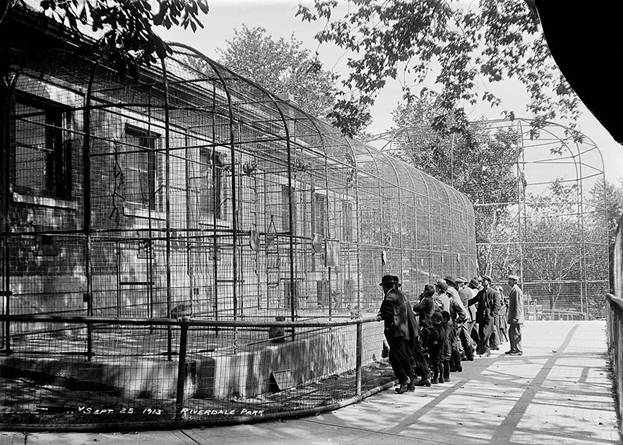Toronto’s first zoo, Riverdale Zoo opened in 1894 on the site of today’s Riverdale Farm on the west side of Riverdale Park [link to Riverdale Park POI]. In 1888, Alderman Daniel Lamb donated some deer to the zoo initiative and encouraged prominent people to donate other animals or provide money to buy them. The first exhibition of animals at the zoo probably took place in 1899.

Riverdale Zoo, monkeys, 25 September 1913. City of Toronto Archives, Fonds 1231, Item 567.
The zoo’s collection grew quickly. By 1902, the zoo had sixteen pheasants, two ocelots, a male camel, a female dromedary, a buffalo bull, six pens of monkeys, a Siberian bear, a young female crane, some lions, and a hippopotamus. That year, the Toronto Railway Company contributed funds to erect the two-storey Moorish style building known as the Donnybrook. The first weekend that the elephant and lions were shown, the Railway Company carried 20,000 people to the zoo. In the early decades of the zoo’s history, its grounds were maintained by prisoners from the Don Jail on the opposite side of the river (typically men who had been imprisoned for minor crimes such as vagrancy).
The Riverdale Zoo was a typical zoo of its period, with animals displayed as curiosities in dark cages and cramped enclosures. In 1949 a citizen's committee was formed to examine the possibilities of a major modern zoo, but it wasn't until the 1960s that things began to move. In 1966, eleven citizens met at City Hall to form the Metropolitan Toronto Zoological Society and in 1967, Metro Council approved Glen Rouge as site for the new zoo. Construction began in 1970 and on August 5, 1974, the Metropolitan Toronto Zoo was opened to the public. The new zoo introduced some innovative features which not only enhanced the public's viewing experience, but also created more comfortable living areas for the animals. Animals were displayed in naturalized environments and grouped according to their geographic region.
The Riverdale Zoo closed its gates for the last time on June 30, 1974, and the animals were shipped to the new zoo in Scarborough. From 1974 to 1978, many of the Riverdale Zoo buildings were torn down and the site levelled. The Residence, the Donnybrook, and the Island House buildings are the only buildings from the old zoo that remain on the site.
The old zoo was converted into an urban farm called Riverdale Farm which officially opened on September 9, 1978. Activities at the farm focus on farm animals and fowl present in Ontario around 1900. Riverdale Farm has seen a number of changes since 1978. An 1850s Pennsylvania-style bank barn was reconstructed on the site; new buildings include the Meeting House and the Simpson House, a replica 1850s-style brick farmhouse.
Text: Lost Rivers and Jennifer Bonnell
Sources
City of Toronto Parks and Recreation: Riverdale Farm. www.toronto.ca/parks/riverdalehistory.htm, accessed May 4, 2009.
Rust-D'Eye, George H. Cabbagetown Remembered. Erin, Ontario: The Boston Mills Press, 1984.
Toronto Historical Association. A Glimpse of Toronto's history: Opportunities for the Commemoration of Lost Historic Sites (Toronto: Toronto Historical Association and the Maps Project, City of Toronto Urban Development Services, 2002), MPLS # 149.
Toronto Zoo. www.torontozoo.com/AboutTheZoo/History, accessed May 4, 2009.
